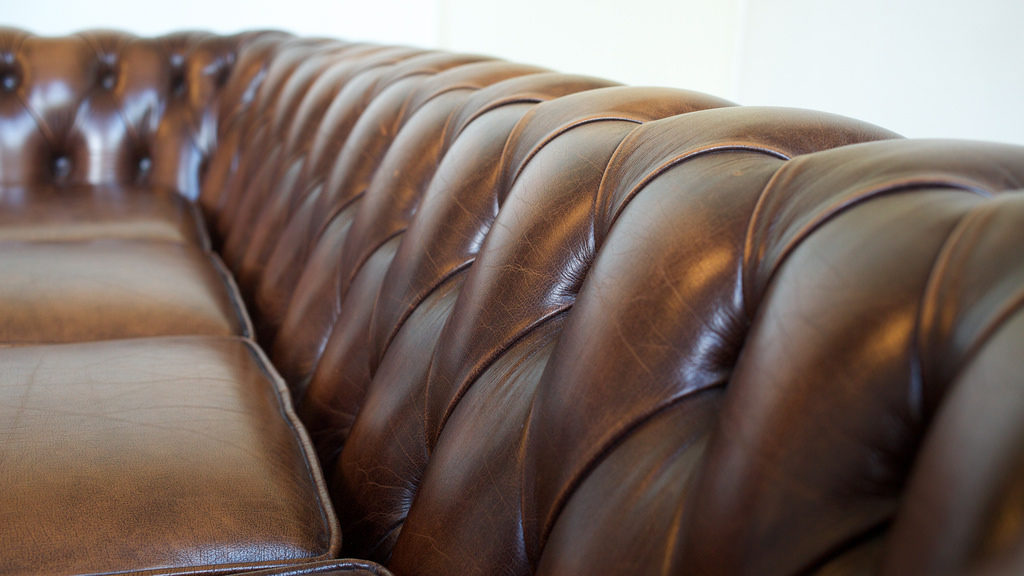Leather is a popular material used in furniture, especially sofas and seats. It’s durable, it looks good, and requires very little maintenance. But that doesn’t mean you should completely neglect your leather upholstery. Cleaning leather furniture is a very simple task provided that you follow the proper instructions. To prevent your leather upholstery from cracking and drying, follow these steps on how to clean and care for leather furniture.
Before we get started, it’s important to identify what kind of leather is used in your upholstery. Different types of leather require a different approach when it comes to cleaning so make sure to check the label on the furniture or look it up on the manufacturer’s website. If you’re not sure about the type of leather your upholstery is, here is how to identify it. We’ll be looking at unprotected leather and protected leather. It is recommended to speak with your local upholstery and leather cleaning professionals for any additional information.

Types of leather upholstery
1. Unprotected leather.
The first type of leather used in furniture and upholstery is aniline leather (also known as unfinished leather or pure aniline). Aniline leather is very soft to the touch and has a luxurious feel to it. It’s dyed with aniline but doesn’t come with any surface pigment color added. Usually, aniline leather has no protective coating and develops a natural patina over time. If you look closely, you’ll see markings and natural grains on the surface of the leather.
Aniline leather is on the higher end of the spectrum and is a bit pricey compared to protected leather, although it’s more prone to staining. Aniline leather comes in a variety of different types including pull-up leather which is oiled and waxed and nubuck leather which is characterised by its soft, velvety texture as a result of buffing or distressing.
2. Protected leather.
Most of the leather used in furniture and upholstery is protected leather. In general, protected leather is more durable, uniform in texture and appearance, and is stain resistant when compared to unprotected leather. This type of leather is known as semi aniline leather. It is dyed with aniline and a surface pigment color is added as well.
It’s also soft to the touch like aniline leather with an added durability thanks to the protective pigment coating applied to it. Other types of protected leather are coated with layers of polymer and pigment to make it more robust and resistant to wear and tear.
How to clean unprotected leather
Cleaning unprotected leather requires special care and attention because it doesn’t have the protective coating protected leather has. Since aniline leather soaks up liquids and stains very easily, it’s important to know the correct approach when removing these stains to preserve the quality of the leather. Learn the proper way on how to clean aniline leather by following the steps below.
- Grab a vacuum cleaner and use an upholstery attachment to remove any loose dust and dirt. Work from top to bottom and make sure to vacuum the nooks and crannies. You can use a vacuum attachment with a soft-bristled brush to thoroughly remove any debris from your upholstery.
- Dampen a leather cleaning sponge with saddle soap and work a good lather by gently rubbing the sponge in a circular motion. Saddle soap is highly recommended because it cleans and conditions aniline leather without drying it out.
- Wipe the lather with a clean cloth and make sure that the leather is free of any soap to prevent buildup. If there are any stains in the upholstery, a special aniline stain remover is recommended. Don’t use toothpaste or any other cleaning agents to prevent damage from the leather
- Use a clean cloth and apply mink oil or other leather preservatives to keep it supple and water-resistant.
How to clean protected leather
Protected leather is much more resilient because it’s treated with a light coat that contains a small amount of pigment. Despite that, protected leather still needs to be cared for to maintain a healthy looking grain.
- Begin by vacuuming the upholstery to remove dust and debris. This makes the cleaning process much easier once you start scrubbing the leather later.
- Use a water-based cleaner to scrub the leather. Spray it on a sponge and scrub in a circular motion to create a lather. You can scrub a bit vigorously when cleaning protected leather as opposed to aniline leather since it’s more durable.
- Wipe down the foam with a clean, dry cloth and let it air dry. Do not dry the upholstery on direct sunlight as this will cause cracking of the leather.
- Use a leather balsam to condition your upholstery after cleaning. Ideally, you want to repeat this process once every six months to maintain the condition of protected leather.
Conclusion
Cleaning leather upholstery is quite a simple process. You want to keep your leather upholstery in good condition by conducting regular cleaning and maintenance. Don’t allow stains to sit for too long as this will make it harder to remove. Remember, only use leather cleaning products and refrain from using harsh liquids like vinegar to preserve the health and look of your leather upholstery.
